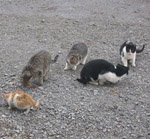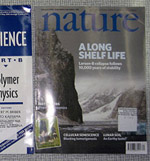Adverse effects: when stream restoration improves habitat for invasive fish
 Fish,
Fish,  Freshwater,
Freshwater,  Invasive,
Invasive,  Restoration
Restoration Stream restoration is a commonly used tool for improving the habitat of threatened native fish, particularly salmonids, which have suffered recent declines due to human disturbances. However, as a new study shows, restoration efforts can create their own problems for native fish by unintentionally improving the habitat of invasive species...
Study links carnivore decline in protected areas to human persecution outside boundary
 Mammals,
Mammals,  Protected Areas
Protected Areas When it comes to protecting at-risk carnivores like the African leopard, conservationists need to pay particular attention to reducing persecution by humans at the edges of preserves. That's the take-home message from a new study in the journal Animal Conservation that looked at leopards in the contiguous Mkhuze and Phinda Game Reserves in South Africa...
The paradoxes of the Endangered Species Act (and how to fix them)
 Policy
Policy In a recent article in the journal Environmental Management, conservation biologist George Wilhere argues that the Endangered Species Act and its provision for habitat conservation plans are hampered by three main paradoxes: the Train Wreck Paradox, the Jeopardy Paradox, and the Maximum Mitigation Paradox. We interview George Wilhere and ask him how we can fix the problem...
Fishing, climate change not double trouble for corals
Do fishing and climate change act synergistically on coral reef ecosystems, meaning the combined impact is greater than the sum of each acting individually? Conservation practitioners have expressed this concern, but synergism in ecosystems has been challenging to prove scientifically...
Study finds high mercury levels, simplified food chain in prairie reservoir
 Fish,
Fish,  Freshwater
Freshwater A new study on mercury levels in prairie reservoirs finds exceedingly high concentrations in northern pike residing in a newly constructed reservoir in Alberta. In addition, the study suggests the reservoir’s food web is extremely simplified, a factor that could be further exacerbating the elevated levels of mercury...
Can animal rights activists and conservationists find common ground?
 Policy
Policy When the staff of the Point Reyes National Seashore in California started reflecting on how to deal with the proliferating non-native deer in the park, it knew it was tackling a sensitive issue. It was concerned about the exotic deer damaging soils and vegetation, competing for food with native tule elk and black-tailed deer, and contaminating them with fatal disease. Yet visitors had grown fond of those endearing park fixtures...







